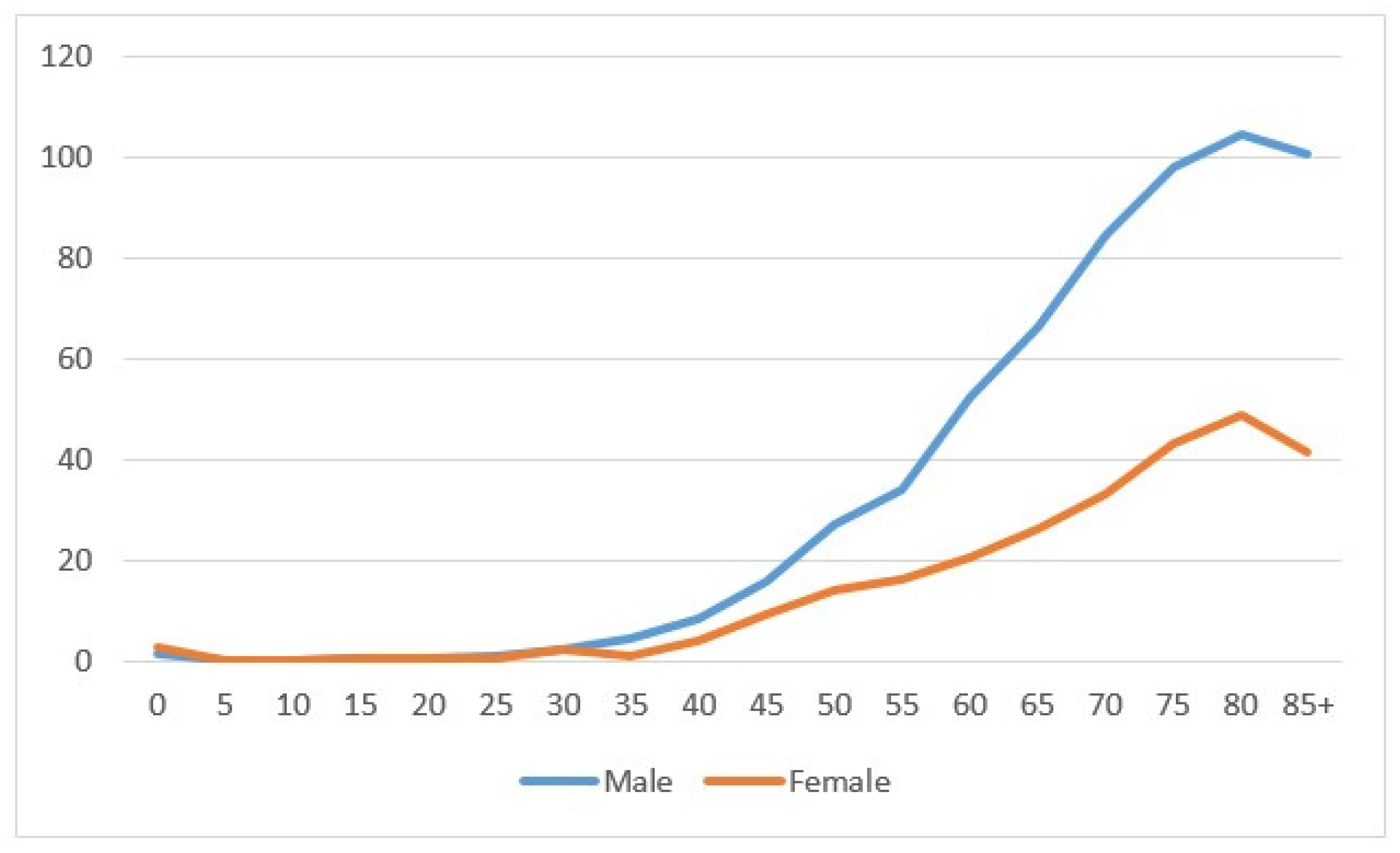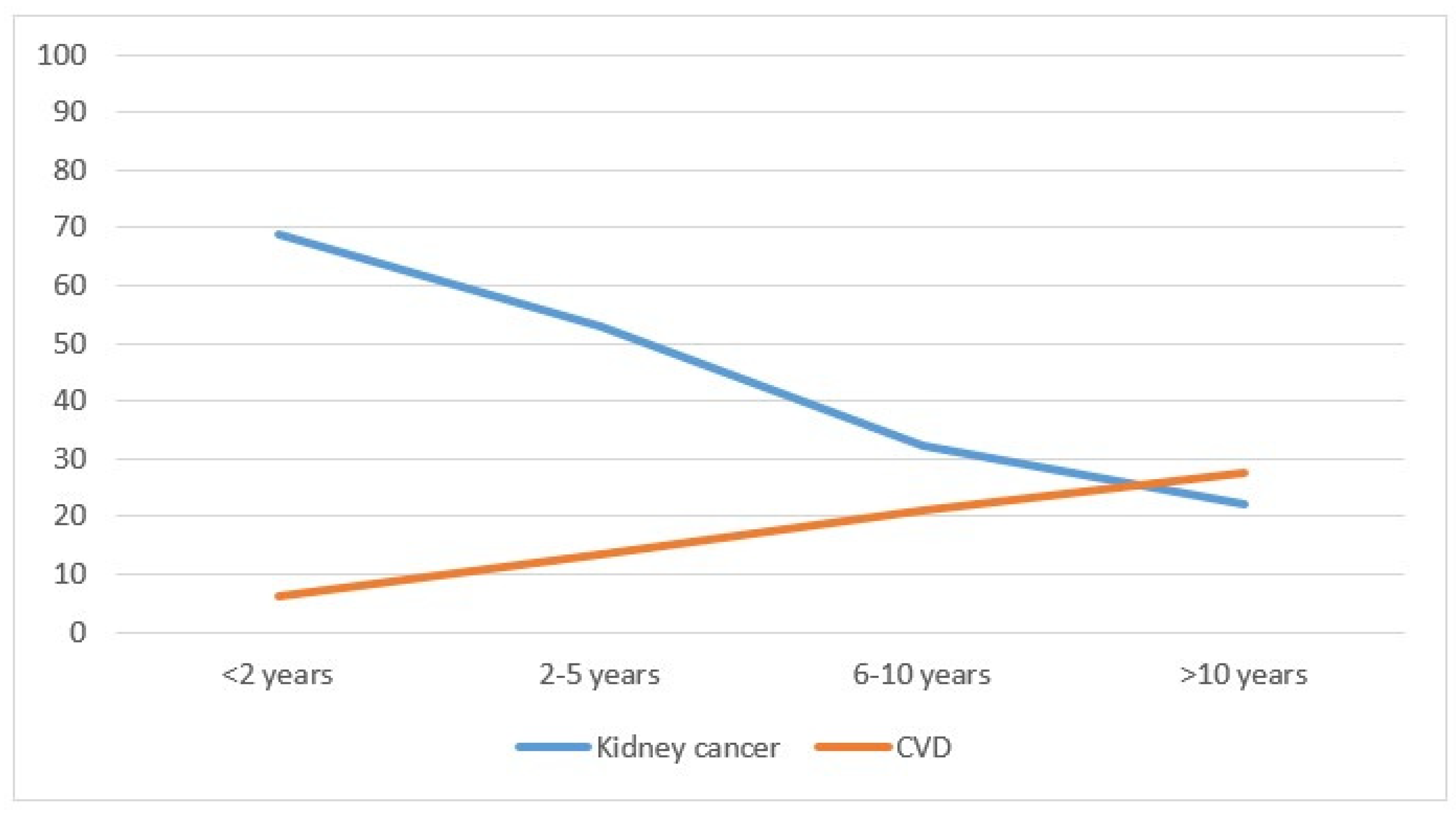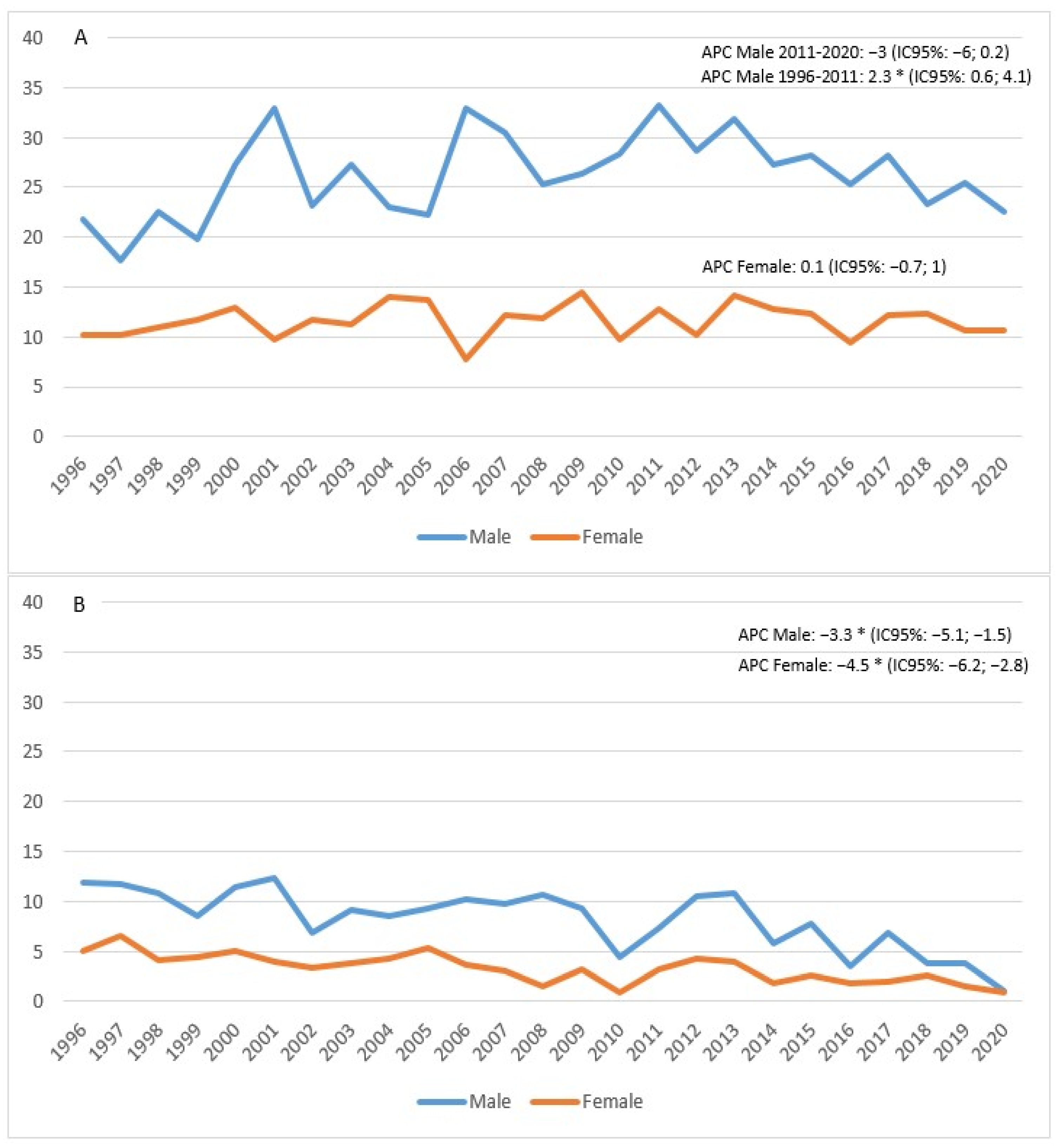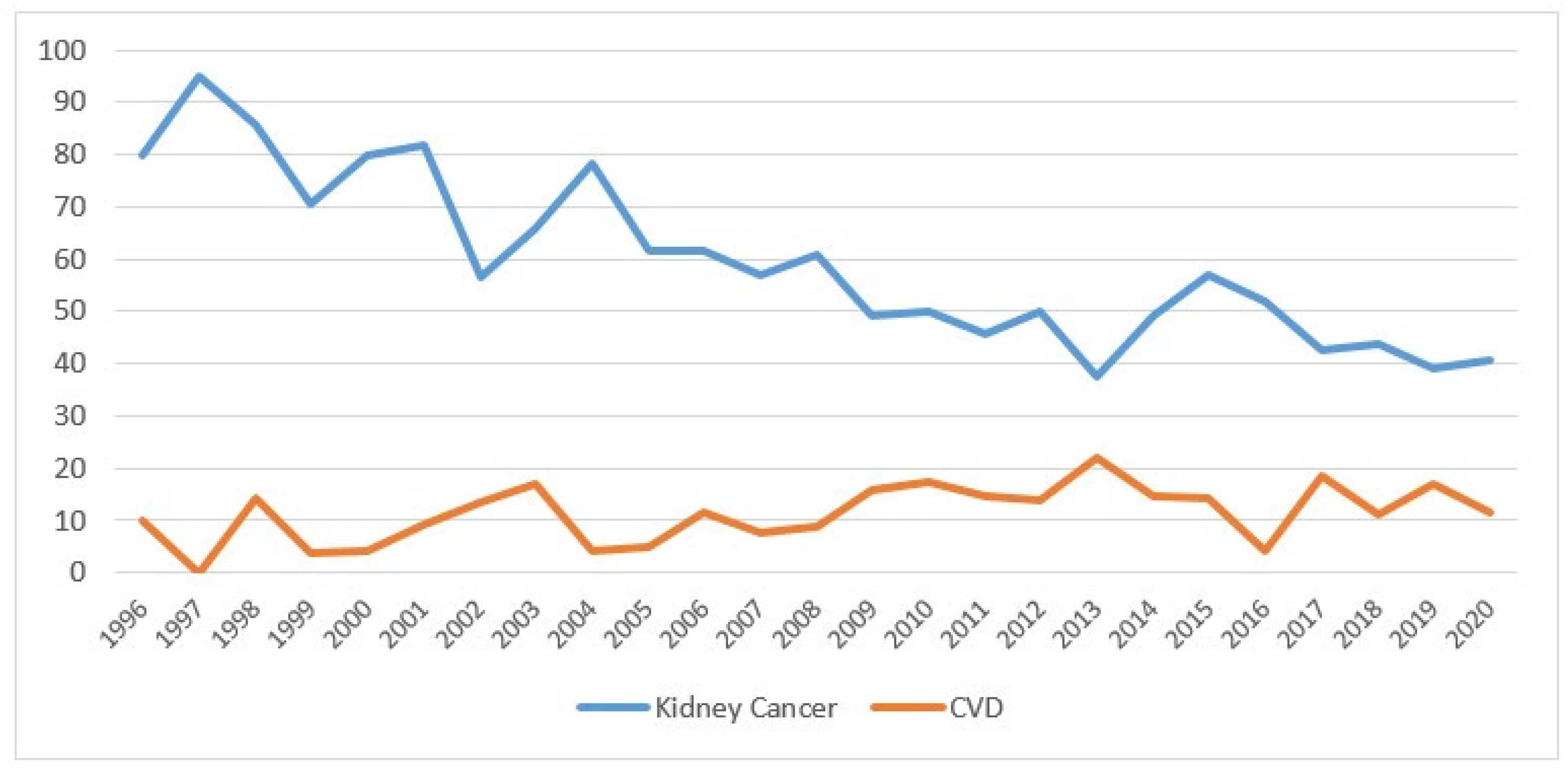Trends in Incidence and Mortality of Kidney Cancer in a Northern Italian Province: An Update to 2020
Abstract
Simple Summary
Abstract
1. Introduction
2. Materials and Methods
2.1. Data Sources
2.2. Statistical Analyses
3. Results
4. Discussion
5. Conclusions
Supplementary Materials
Author Contributions
Funding
Institutional Review Board Statement
Informed Consent Statement
Data Availability Statement
Conflicts of Interest
References
- AIOM-AIRTUM-SIAPEC-IAP. I Numeri del Cancro in Italia; Intermedia Editore: Brescia, Italy, 2020. [Google Scholar]
- Azawi, N.H.; Joergensen, S.M.; Jensen, N.V.; Clark, P.E.; Lund, L. Academy of Geriatric Cancer Research (AgeCare). Trends in kidney cancer among the elderly in Denmark, 1980–2012. Acta Oncol. 2016, 55 (Suppl. 1), 79–84. [Google Scholar] [CrossRef]
- López-Abente, G.; Aragonés, N.; Pérez-Gómez, B.; Ramis, R.; Vidal, E.; García-Pérez, J.; Fernández-Navarro, P.; Pollán, M. Kidney cancer mortality in Spain: Geographic patterns and possible hypotheses. BMC Cancer 2008, 9, 293. [Google Scholar] [CrossRef] [PubMed][Green Version]
- De, P.; Otterstatter, M.C.; Semenciw, R.; Ellison, L.F.; Marrett, L.D.; Dryer, D. Trends in incidence, mortality, and survival for kidney cancer in Canada, 1986–2007. Cancer Causes Control. 2014, 25, 1271–1281. [Google Scholar] [CrossRef] [PubMed]
- Chow, W.H.; Dong, L.M.; Devesa, S.S. Epidemiology and risk factors for kidney cancer. Nat. Rev. Urol. 2010, 7, 245–257. [Google Scholar] [CrossRef] [PubMed]
- Gandaglia, G.; Ravi, P.; Abdollah, F.; Abd-El-Barr, A.E.; Becker, A.; Popa, I.; Briganti, A.; Karakiewicz, P.I.; Trinh, Q.D.; Jewett, M.A.; et al. Contemporary incidence and mortality rates of kidney cancer in the United States. Can. Urol. Assoc. J. 2014, 8, 247–252. [Google Scholar] [CrossRef] [PubMed]
- Lipworth, L.; Tarone, R.E.; Lund, L.; Mclaughlin, J.K. Epidemiologic characteristics and risk factors for renal cell cancer. Clin. Epidemiol. 2009, 1, 33–43. [Google Scholar]
- IARC. Monographs on the Evaluation of Carcinogenesis Risks to Humans: Tobacco Smoke and Involuntary Smoking; International Agency for Research on Cancer: Lyon, France, 2004. [Google Scholar]
- US Department of Health and Human Services. The Health Consequences of Smoking: A Report of the Surgeon General; Centers for Disease Control and Prevention, National Center for Chronic Disease Prevention and Health Promotion, Office on Smoking and Health: Atlanta, GA, USA, 2004.
- Hunt, J.D.; van der Hel, O.L.; McMillan, G.P.; Boffetta, P.; Brennan, P. Renal cell carcinoma in relation to cigarette smoking: Meta-analysis of 24 studies. Int. J. Cancer 2005, 114, 101–108. [Google Scholar] [CrossRef]
- Calle, E.E.; Kaaks, R. Overweight, obesity and cancer: Epidemiological evidence and proposed mechanisms. Nat. Rev. Cancer 2004, 4, 579–591. [Google Scholar] [CrossRef]
- Mittal, B.V.; Singh, A.K. Hypertension in the developing world: Challenges and opportunities. Am. J. Kidney Dis. 2010, 55, 590–598. [Google Scholar] [CrossRef]
- IARC. Monographs on the Evaluation of Carcinogenic Risks to Humans: Dry Cleaning, Some Chlorinated Solvents and Other Industrial Chemicals; International Agency for Research on Cancer: Lyon, France, 1995. [Google Scholar]
- Kaelin, W.G. Von Hippel-Lindau disease. Annu. Rev. Pathol. 2007, 2, 145–173. [Google Scholar] [CrossRef]
- Janzen, N.K.; Kim, H.L.; Figlin, R.A.; Belldegrun, A.S. Surveillance after radical or partial nephrectomy for localized renal cell carcinoma and management of recurrent disease. Urol. Clin. N. Am. 2003, 30, 843–852. [Google Scholar] [CrossRef]
- Patard, J.J. Incidental renal tumours. Curr. Opin. Urol. 2009, 19, 454–458. [Google Scholar] [CrossRef] [PubMed]
- Chow, W.H.; Devesa, S.S. Contemporary epidemiology of renal cell cancer. Cancer J. 2008, 14, 288–301. [Google Scholar] [CrossRef] [PubMed]
- Gill, I.S.; Aron, M.; Gervais, D.A.; Jewett, M.A. Clinical practice. Small renal mass. N. Engl. J. Med. 2010, 362, 624–634. [Google Scholar] [CrossRef] [PubMed]
- Mangone, L.; Bossard, N.; Marcos-Gragera, R.; Pezzarossi, A.; Roncaglia, F.; Giorgi Rossi, P.; GRELL EUROCARE-5 Working Group. Trends in net survival from kidney cancer in six European Latin countries: Results from the SUDCAN population-based study. Eur. J. Cancer Prev. 2017, 26, S121–S127. [Google Scholar] [CrossRef]
- Sung, W.W.; Wang, S.C.; Hsieh, T.Y.; Ho, C.J.; Huang, C.Y.; Kao, Y.L.; Chen, W.J.; Chen, S.L. Favorable mortality-to-incidence ratios of kidney Cancer are associated with advanced health care systems. BMC Cancer 2018, 18, 792. [Google Scholar] [CrossRef]
- Li, P.; Wong, Y.N.; Armstrong, K.; Haas, N.; Subedi, P.; Davis-Cerone, M.; Doshi, J.A. Survival among patients with advanced renal cell carcinoma in the pretargeted versus targeted therapy eras. Cancer Med. 2016, 5, 169–181. [Google Scholar] [CrossRef]
- Shao, N.; Wan, F.; Abudurexiti, M.; Wang, J.; Zhu, Y.; Ye, D. Causes of Death and Conditional Survival of Renal Cell Carcinoma. Front. Oncol. 2019, 9, 591. [Google Scholar] [CrossRef]
- Kang, M.; Park, J.Y.; Jeong, C.W.; Hwang, E.C.; Song, C.; Hong, S.H.; Kwak, C.; Chung, J.; Sung, H.H.; Jeon, H.G.; et al. Changeable Conditional Survival Rates and Associated Prognosticators in Patients with Metastatic Renal Cell Carcinoma Receiving First Line Targeted Therapy. J. Urol. 2018, 200, 989–995. [Google Scholar] [CrossRef]
- Soerensen, A.V.; Donskov, F.; Hermann, G.G.; Jensen, N.V.; Petersen, A.; Spliid, H.; Sandin, R.; Fode, K.; Geertsen, P.F. Improved overall survival after implementation of targeted therapy for patients with metastatic renal cell carcinoma: Results from the Danish Renal Cancer Group (DARENCA) study-2. Eur. J. Cancer 2014, 50, 553–562. [Google Scholar] [CrossRef]
- Wallen, E.M.; Pruthi, R.S.; Joyce, G.F.; Wise, M. Urologic Diseases in America Project. Kidney cancer. J. Urol. 2007, 177, 2006. [Google Scholar] [CrossRef] [PubMed]
- Li, J.; Weir, H.K.; Jim, M.A.; King, S.M.; Wilson, R.; Master, V.A. Kidney cancer incidence and mortality among American Indians and Alaska Natives in the United States, 1990–2009. Am. J. Public Health 2014, 104 (Suppl. 3), S396–S403. [Google Scholar] [CrossRef]
- Wong, M.C.S.; Goggins, W.B.; Yip, B.H.K.; Fung, F.D.H.; Leung, C.; Fang, Y.; Wong, S.Y.S.; Ng, C.F. Incidence and mortality of kidney cancer: Temporal patterns and global trends in 39 countries. Sci. Rep. 2017, 7, 15698. [Google Scholar] [CrossRef] [PubMed]
- Znaor, A.; Lortet-Tieulent, J.; Laversanne, M.; Jemal, A.; Bray, F. International variations and trends in renal cell carcinoma incidence and mortality. Eur. Urol. 2015, 67, 519–530. [Google Scholar] [CrossRef] [PubMed]
- Orphanos, G.S.; Ioannidis, G.N.; Ardavanis, A.G. Cardiotoxicity induced by tyrosine kinase inhibitors. Acta Oncol. 2009, 48, 964–970. [Google Scholar] [CrossRef]
- Fritz, A.; Percy, C.; Jack, A.; Shanmugaratnam, K.; Sobin, L.; Parkin, D.; Whelan, S. International Classification of Disease for Oncology, 3rd ed.; World Health Organization: Geneva, Switzerland, 2000. [Google Scholar]
- World Health Organization. International Statistical Classification of Diseases and Related Health Problems, 10th ed.; World Health Organization: Geneva, Switzerland, 1992. [Google Scholar]
- Sung, H.; Ferlay, J.; Siegel, R.L.; Laversanne, M.; Soerjomataram, I.; Jemal, A.; Bray, F. Global cancer statistics 2020: Globocan estimates of incidence and mortality worldwide for 36 cancers in 185 countries. CA Cancer J. Clin. 2021, 71, 209–249. [Google Scholar] [CrossRef]
- Rabjerg, M.; Mikkelsen, M.N.; Walter, S.; Marcussen, N. Incidental renal neoplasms: Is there a need for routine screening? A Danish single-center epidemiological study. APMIS 2014, 122, 708–714. [Google Scholar] [CrossRef]
- Capitanio, U.; Larcher, A.; Cianflone, F.; Trevisani, F.; Nini, A.; Mottrie, A.; Mari, A.; Campi, R.; Tellini, R.; Briganti, A.; et al. Hypertension and Cardiovascular Morbidity Following Surgery for Kidney Cancer. Eur. Urol. Oncol. 2020, 3, 209–215. [Google Scholar] [CrossRef]
- Li, L.; Lau, W.L.; Rhee, C.M.; Harley, K.; Kovesdy, C.P.; Sim, J.J.; Jacobsen, S.; Chang, A.; Landman, J.; Kalantar-Zadeh, K. Risk of chronic kidney disease after cancer nephrectomy. Nat. Rev. Nephrol. 2014, 10, 135–145. [Google Scholar] [CrossRef]
- Ferlay, J.; Colombet, M.; Soerjomataram, I.; Mathers, C.; Parkin, D.M.; Piñeros, M.; Znaor, A.; Bray, F. Estimating the global cancer incidence and mortality in 2018: GLOBOCAN sources and methods. Int. J. Cancer 2019, 144, 1941–1953. [Google Scholar] [CrossRef]
- Mangone, L.; Mancuso, P.; Tarantini, L.; Larocca, M.; Bisceglia, I.; Damato, A.; Giorgi Rossi, P.; Navazio, A.; Pinto, C. A Population-Based Study of Cardiovascular Disease Mortality in Italian Cancer Patients. Cancers 2021, 13, 5903. [Google Scholar] [CrossRef] [PubMed]
- Motzer, R.J.; Hutson, T.E.; Tomczak, P.; Michaelson, M.D.; Bukowski, R.M.; Oudard, S.; Negrier, S.; Szczylik, C.; Pili, R.; Bjarnason, G.A.; et al. Overall survival and updated results for sunitinib compared with interferon alfa in patients with metastatic renal cell carcinoma. Clin. Oncol. 2009, 7, 3584–3590. [Google Scholar] [CrossRef] [PubMed]
- Gore, M.E.; Szczylik, C.; Porta, C.; Bracarda, S.; Bjarnason, G.A.; Oudard, S.; Hariharan, S.; Lee, S.H.; Haanen, J.; Castellano, D.; et al. Safety and efficacy of sunitinib for metastatic renal-cell carcinoma: An expanded-access trial. Lancet Oncol. 2009, 10, 757–763. [Google Scholar] [CrossRef]
- Motzer, R.J.; Tannir, N.M.; McDermott, D.F.; Arén Frontera, O.; Melichar, B.; Choueiri, T.K.; Plimack, E.R.; Barthélémy, P.; Porta, C.; George, S.; et al. Nivolumab plus Ipilimumab versus Sunitinib in Advanced Renal-Cell Carcinoma. N. Engl. J. Med. 2018, 378, 1277–1290. [Google Scholar] [CrossRef]
- Choueiri, T.K.; Escudier, B.; Powles, T.; Tannir, N.M.; Mainwaring, P.N.; Rini, B.I.; Hammers, H.J.; Donskov, F.; Roth, B.J.; Peltola, K.; et al. METEOR investigators. Cabozantinib versus everolimus in advanced renal cell carcinoma (METEOR): Final results from a randomised, open-label, phase 3 trial. Lancet Oncol. 2016, 17, 917–927. [Google Scholar] [CrossRef]
- Rini, B.I.; Plimack, E.R.; Stus, V.; Gafanov, R.; Hawkins, R.; Nosov, D.; Pouliot, F.; Alekseev, B.; Soulières, D.; Melichar, B.; et al. Pembrolizumab plus Axitinib versus Sunitinib for Advanced Renal-Cell Carcinoma. N. Engl. J. Med. 2019, 380, 1116–1127. [Google Scholar] [CrossRef] [PubMed]
- Choueiri, T.K.; Powles, T.; Burotto, M.; Escudier, B.; Bourlon, M.T.; Zurawski, B.; Oyervides Juárez, V.M.; Hsieh, J.J.; Basso, U.; Shah, A.Y.; et al. Nivolumab plus Cabozantinib versus Sunitinib for Advanced Renal-Cell Carcinoma. N. Engl. J. Med. 2021, 384, 829–841. [Google Scholar] [CrossRef]
- Motzer, R.; Alekseev, B.; Rha, S.Y.; Porta, C.; Eto, M.; Powles, T.; Grünwald, V.; Hutson, T.E.; Kopyltsov, E.; Méndez-Vidal, M.J.; et al. Lenvatinib plus Pembrolizumab or Everolimus for Advanced Renal Cell Carcinoma. N. Engl. J. Med. 2021, 384, 1289–1300. [Google Scholar] [CrossRef]
- Motzer, R.J.; Penkov, K.; Haanen, J.; Rini, B.; Albiges, L.; Campbell, M.T.; Venugopal, B.; Kollmannsberger, C.; Negrier, S.; Uemura, M.; et al. Avelumab plus Axitinib versus Sunitinib for Advanced Renal-Cell Carcinoma. N. Engl. J. Med. 2019, 380, 1103–1115. [Google Scholar] [CrossRef]
- Porta, C.; Rizzo, M. Recent advances in the frontline treatment of metastatic renal cell carcinoma. J. Cancer Metastasis Treat. 2021, 7, 49. [Google Scholar] [CrossRef]
- Neagoe, P.E.; Lemieux, C.; Sirois, M.G. Vascular endothelial growth factor (VEGF)-A165-induced prostacyclin synthesis requires the activation of VEGF receptor-1 and -2 heterodimer. J. Biol. Chem. 2005, 280, 9904–9912. [Google Scholar] [CrossRef] [PubMed]
- Mangone, L.; Gioia, F.; Mancuso, P.; Bisceglia, I.; Ottone, M.; Vicentini, M.; Pinto, C.; Giorgi Rossi, P. Cumulative COVID-19 incidence, mortality and prognosis in cancer survivors: A population-based study in Reggio Emilia, Northern Italy. Int. J. Cancer 2021, 149, 820–826. [Google Scholar] [CrossRef] [PubMed]
- Mangone, L.; Giorgi Rossi, P.; Bisceglia, I.; Grilli, R.; Pinto, C. The impact of COVID-19 on new cancer diagnoses. Ann. Oncol. Res. 2021, 1, 36–42. [Google Scholar] [CrossRef]





| Incidence | Cause-Specific Mortality | Overall Deaths | ||||
|---|---|---|---|---|---|---|
| Cancer Patients | Kidney Cancer Deaths | Other Cancer Deaths | CVD Deaths | Other Causes of Death | No. of Deaths | |
| No. | No. (%) | No. (%) | No. (%) | No. (%) | No. (%) | |
| All | 2331 | 688 (54.7) | 183 (14.6) | 155 (12.3) | 231 (18.4) | 1257 (100) |
| Sex | ||||||
| Male | 1504 | 447 (54.9) | 126 (15.5) | 99 (12.1) | 143 (17.5) | 815 (100) |
| Female | 827 | 241 (54.5) | 57 (12.9) | 56 (12.7) | 88 (19.9) | 442 (100) |
| p-value | 0.91 | 0.22 | 0.79 | 0.30 | ||
| Age at diagnosis | ||||||
| 0–39 | 66 | 6 (75.0) | 2 (25.0) | 0 (0.0) | 0 (0.0) | 8 (100) |
| 40–59 | 535 | 111 (70.7) | 23 (14.7) | 3 (1.9) | 20 (12.7) | 157 (100) |
| 60–79 | 1240 | 375 (53.7) | 105 (15.0) | 101 (14.5) | 117 (16.8) | 698 (100) |
| 80+ | 490 | 196 (49.8) | 53 (13.4) | 51 (12.9) | 94 (23.9) | 394 (100) |
| p-value | <0.01 | 0.75 | <0.01 | <0.01 | ||
| Year of diagnosis | ||||||
| 1996–2000 | 349 | 164 (59.2) | 29 (10.5) | 41 (14.8) | 43 (15.5) | 277 (100) |
| 2001–2005 | 431 | 153 (52.4) | 58 (19.9) | 40 (13.7) | 41 (14.0) | 292 (100) |
| 2006–2010 | 480 | 134 (43.8) | 54 (17.7) | 55 (18.0) | 63 (20.6) | 306 (100) |
| 2011–2015 | 559 | 157 (62.1) | 29 (11.5) | 14 (5.5) | 53 (20.9) | 253 (100) |
| 2016–2020 | 512 | 80 (62.0) | 13 (10.1) | 5 (3.9) | 31 (24.0) | 129 (100) |
| p-value | <0.01 | <0.01 | <0.01 | <0.05 | ||
| Years since diagnosis | ||||||
| <2 years | 899 | 448 (68.9) | 80 (12.3) | 40 (6.2) | 82 (12.6) | 650 (100) |
| 2–5 years | 564 | 148 (52.9) | 41 (14.6) | 38 (13.6) | 53 (18.9) | 280 (100) |
| 6–10 years | 445 | 63 (32.1) | 38 (19.4) | 41 (20.9) | 54 (27.6) | 196 (100) |
| >10 years | 423 | 29 (22.1) | 24 (18.3) | 36 (27.5) | 42 (32.1) | 131 (100) |
| p-value | <0.01 | 0.05 | <0.01 | <0.01 | ||
| Year of death * | ||||||
| 1996–2000 | 349 | 90 (81.8) | 8 (7.3) | 7 (6.4) | 5 (4.5) | 110 (100) |
| 2001–2005 | 711 | 135 (69.3) | 25 (12.8) | 19 (9.7) | 16 (8.2) | 195 (100) |
| 2006–2010 | 952 | 148 (55.6) | 50 (18.8) | 33 (12.4) | 35 (13.2) | 266 (100) |
| 2011–2015 | 1161 | 159 (48.3) | 43 (13.1) | 52 (15.8) | 75 (22.8) | 329 (100) |
| 2016–2020 | 1346 | 156 (43.7) | 57 (16.0) | 44 (12.3) | 100 (28.0) | 357 (100) |
| p-value | <0.01 | <0.05 | 0.07 | <0.01 | ||
Publisher’s Note: MDPI stays neutral with regard to jurisdictional claims in published maps and institutional affiliations. |
© 2022 by the authors. Licensee MDPI, Basel, Switzerland. This article is an open access article distributed under the terms and conditions of the Creative Commons Attribution (CC BY) license (https://creativecommons.org/licenses/by/4.0/).
Share and Cite
Mangone, L.; Marinelli, F.; Tarantini, L.; Masini, C.; Navazio, A.; Di Girolamo, S.; Bisceglia, I.; Pinto, C. Trends in Incidence and Mortality of Kidney Cancer in a Northern Italian Province: An Update to 2020. Biology 2022, 11, 1048. https://doi.org/10.3390/biology11071048
Mangone L, Marinelli F, Tarantini L, Masini C, Navazio A, Di Girolamo S, Bisceglia I, Pinto C. Trends in Incidence and Mortality of Kidney Cancer in a Northern Italian Province: An Update to 2020. Biology. 2022; 11(7):1048. https://doi.org/10.3390/biology11071048
Chicago/Turabian StyleMangone, Lucia, Francesco Marinelli, Luigi Tarantini, Cristina Masini, Alessandro Navazio, Stefania Di Girolamo, Isabella Bisceglia, and Carmine Pinto. 2022. "Trends in Incidence and Mortality of Kidney Cancer in a Northern Italian Province: An Update to 2020" Biology 11, no. 7: 1048. https://doi.org/10.3390/biology11071048
APA StyleMangone, L., Marinelli, F., Tarantini, L., Masini, C., Navazio, A., Di Girolamo, S., Bisceglia, I., & Pinto, C. (2022). Trends in Incidence and Mortality of Kidney Cancer in a Northern Italian Province: An Update to 2020. Biology, 11(7), 1048. https://doi.org/10.3390/biology11071048









